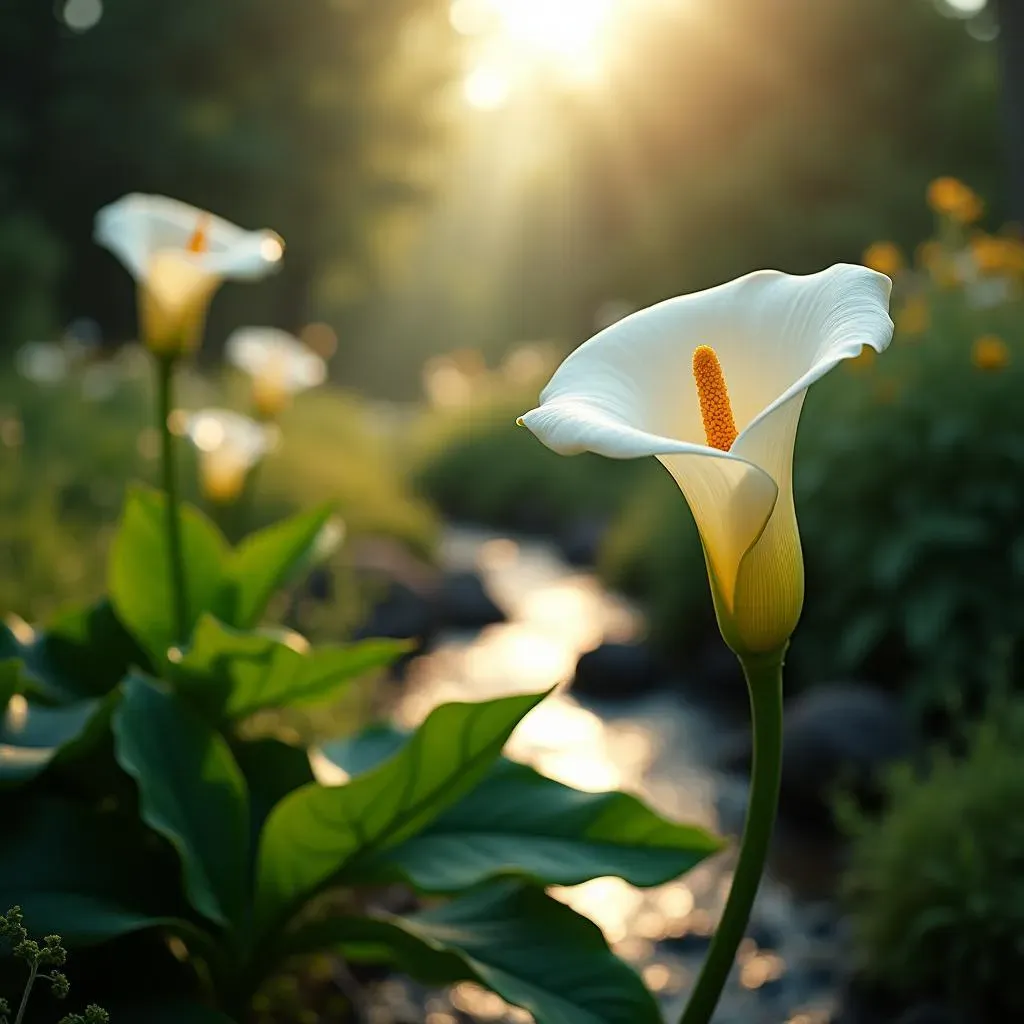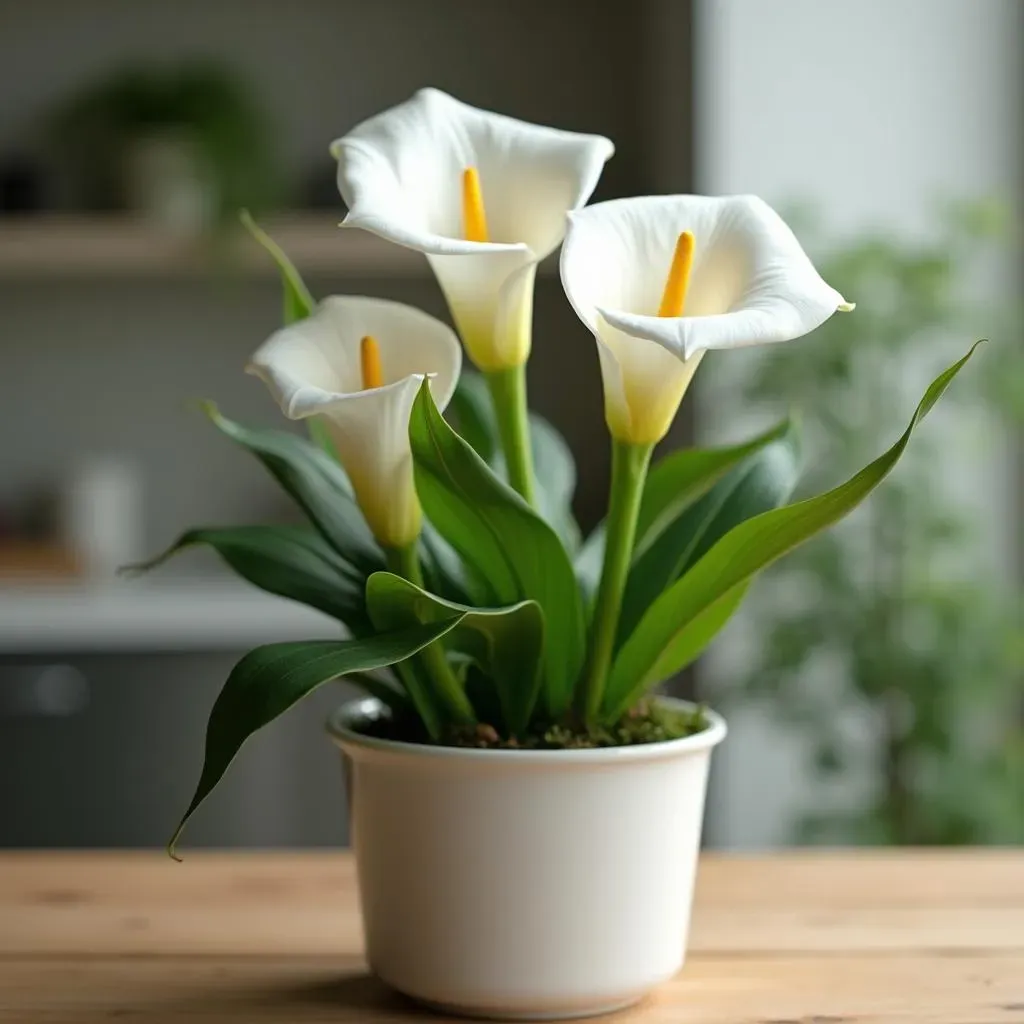Table of Contents
Ever stared at your calla lily, wondering, "why is my calla lily not flowering?" It's a common garden mystery, and honestly, it can be a bit frustrating. These elegant plants, with their sleek, trumpet-shaped blooms, are supposed to be showstoppers, not silent green statues. You're not alone if your calla lily is refusing to put on a floral display. In this article, we'll explore the most common reasons behind this no-bloom situation. We will uncover the secrets to getting those gorgeous flowers. From sunlight and soil to water and nutrients, we'll cover everything your calla lily needs to thrive. We’ll break down the steps to coax your plant into blooming, and how to keep those flowers coming year after year. So, get ready to transform your non-blooming calla lily into a stunning floral masterpiece. Let's dive in and bring those blooms to life!
Why Your Calla Lily Isn't Blooming: Common Reasons

Why Your Calla Lily Isn't Blooming: Common Reasons
So, your calla lily is being a bit of a drama queen and refusing to bloom? Don't worry, it happens to the best of us. There's usually a reason why these beauties decide to skip the flower show. One of the biggest culprits is too much nitrogen. I know, it sounds counterintuitive, but it’s true. Nitrogen is great for leafy growth, but it can actually hinder flower production. Think of it like this: the plant is so busy bulking up its leaves that it doesn’t have the energy to make flowers. Another common reason is lack of sunlight. Calla lilies are sun-lovers, and if they're not getting enough light, they simply won't bloom. Imagine trying to sunbathe in a dark room; you wouldn’t get a tan, would you? Well, your calla lily won’t get its blooms either.
Then there's the water situation. Too little, and your plant is thirsty and stressed, too much, and you might be dealing with root rot, which is a big no-no for blooming. It's a delicate balance, kind of like trying to make the perfect cup of tea. And let's not forget about pests and diseases. Aphids, spider mites, and fungal issues can all weaken your plant, making it too busy fighting off invaders to even think about flowering. It's like trying to run a marathon with a bad cold – not going to happen. Finally, sometimes, calla lilies just need a rest. They have a dormancy period, and if you're expecting blooms during this time, you'll be disappointed. It’s like expecting a bear to come out of hibernation in the middle of winter; they just need their sleep.
Reason | Explanation |
|---|---|
Excess Nitrogen | Promotes leafy growth, but inhibits flowering. |
Insufficient Sunlight | Calla lilies need ample light to bloom. |
Improper Watering | Too little or too much can stress the plant. |
Pests and Diseases | Weakens the plant and prevents blooming. |
Dormancy | Calla lilies need a rest period. |
Sunlight, Water, and Soil: The Perfect Recipe for Calla Lilies

Sunlight, Water, and Soil: The Perfect Recipe for Calla Lilies
Okay, so we've figured out what's *not* working for your calla lily. Now, let's talk about the good stuff: sunlight, water, and soil – the holy trinity for happy, blooming plants. Think of it like baking a cake; you need the right ingredients in the right amounts for it to turn out amazing. For sunlight, these guys are like sunbathers at the beach, they need a good six hours of bright, indirect light daily. Direct afternoon sun can scorch their leaves, so a spot that gets morning sun and some afternoon shade is perfect. If you're growing them indoors, a south-facing window is your best bet, but keep an eye out for leaf burn.
Next up, water. Calla lilies are thirsty, but they also don't like soggy feet. The key is to keep the soil consistently moist, but not waterlogged. Imagine a damp sponge – that's the kind of moisture you're aiming for. When the top inch of soil feels dry to the touch, it's time to water. And make sure your pot has good drainage holes; nobody likes sitting in a puddle. As for soil, calla lilies prefer well-draining, slightly acidic soil. A good potting mix with some added compost or peat moss works wonders. It's like giving them a comfy bed to rest in. If the soil is too dense or compacted, the roots won’t get enough air, and that’s never a good thing.
Element | Ideal Condition |
|---|---|
Sunlight | 6 hours of bright, indirect light daily |
Water | Consistently moist, but not waterlogged soil |
Soil | Well-draining, slightly acidic potting mix |
How to Make Your Calla Lily Flower: Easy Steps

How to Make Your Calla Lily Flower: Easy Steps
Adjusting the Environment
Alright, so you've got the basics down, but how do you actually get those stubborn calla lilies to bloom? It’s not magic, but it does take a bit of tweaking. First, let's talk about location. If your calla lily is indoors, make sure it's in a spot where it gets plenty of bright, indirect light. Rotate the pot regularly to ensure even growth. If it's outdoors, consider moving it to a location that gets morning sun and afternoon shade. If you suspect the light is the issue, try moving it to different spots and observe how it reacts. Sometimes, a little change of scenery is all it takes.
Next, water is key. Remember, we're aiming for moist, not soggy soil. Use your finger to check the soil moisture, if it feels dry about an inch deep, water it. Make sure you’re using a pot with proper drainage. And how about fertilizer? If you've been using a high-nitrogen fertilizer, switch to one that's higher in phosphorus. Phosphorus is what promotes blooming, so it's like giving your plant a little nudge in the right direction. You don't need to go overboard; a balanced liquid fertilizer diluted to half strength every two to four weeks during the growing season is usually sufficient.
Step | Action |
|---|---|
Light | Provide bright, indirect light; rotate pot regularly. |
Water | Keep soil moist, not soggy; ensure good drainage. |
Fertilizer | Use a balanced liquid fertilizer higher in phosphorus. |
Addressing Dormancy and Other Issues
Now, let’s talk about dormancy. If your calla lily has been growing for a while and hasn't bloomed, it might just need a rest. Reduce watering and let the leaves die back. This usually happens naturally in the fall or winter. Once the leaves are gone, you can store the bulb in a cool, dark place until it’s time to start the growing cycle again in the spring. It’s like giving your plant a vacation so it can come back refreshed and ready to bloom.
Also, don’t forget about pest control. Regularly check your plant for any signs of aphids, spider mites, or other unwanted guests. If you spot any, treat them with an appropriate insecticide or a natural solution like neem oil. A healthy plant is a happy plant, and happy plants bloom. And finally, remember to deadhead spent flowers. This encourages the plant to produce new blooms. It’s like telling your plant, “Hey, you did a good job, now let's do it again!” These little actions can make a big difference.
- Reduce watering during dormancy.
- Check for pests and treat them accordingly.
- Deadhead spent flowers to encourage new blooms.
Keeping Your Calla Lily Blooming: LongTerm Care

Keeping Your Calla Lily Blooming: LongTerm Care
Regular Care for Continuous Blooms
So, you've finally got your calla lily blooming – congrats! But the journey doesn't end there. To keep those gorgeous flowers coming back year after year, you need a solid long-term care plan. Think of it like maintaining a car; you can't just drive it and expect it to run forever without some TLC. Regular fertilization is key, especially during the growing season. Use a balanced liquid fertilizer, diluted to half strength, every two to four weeks. This ensures your plant has the nutrients it needs to produce new blooms. Also, don’t forget to deadhead spent flowers. This encourages the plant to put its energy into new growth rather than seed production. It’s like clearing away the old to make room for the new.
Watering is also super important. Keep the soil consistently moist, but not waterlogged. Check the soil regularly, and water when the top inch feels dry. Proper drainage is crucial to prevent root rot, so make sure your pot has drainage holes. And let's talk about repotting. If your calla lily is in a pot, it'll eventually need to be repotted, usually every year or two. Choose a pot that’s slightly larger than the current one and use fresh potting mix. This gives the roots room to grow and ensures your plant has access to fresh nutrients. It's like giving your plant a bigger apartment to stretch out in.
Seasonal Adjustments and Dormancy
Calla lilies have different needs depending on the season. During the growing season, they need plenty of light, water, and fertilizer. But when fall rolls around, it's time to prepare them for their dormancy period. As the leaves start to yellow and die back, reduce watering gradually. Once the leaves are completely gone, you can store the bulb in a cool, dark, and dry place. It's like tucking your plant in for a long winter's nap. Don’t worry, it will wake up in the spring!
Care Aspect | During Growing Season | During Dormancy |
|---|---|---|
Watering | Keep soil consistently moist | Reduce watering, let soil dry out |
Fertilizing | Fertilize every 2-4 weeks | Stop fertilizing |
Light | Provide plenty of bright light | Store in cool, dark place |
Pest and Disease Prevention
Keeping an eye out for pests and diseases is also a key part of long-term care. Regularly inspect your calla lily for any signs of trouble, such as aphids, spider mites, or fungal issues. If you spot any, treat them immediately with an appropriate insecticide or fungicide. You can also use natural solutions like neem oil. Remember, prevention is always better than cure, so keeping your plant healthy and strong will make it less susceptible to problems. It's like building a strong immune system for your plant.
And one last pro tip, sometimes calla lilies can become overcrowded. If you notice your plant is getting too bushy, consider dividing it. This is usually done in the spring, when you’re repotting. Carefully separate the rhizomes (the underground stems) and plant them in separate pots. This not only prevents overcrowding but also gives you more calla lilies to enjoy! So, with a little bit of care and attention, you can keep your calla lily blooming beautifully for years to come. It’s all about understanding its needs and providing the right environment.
- Regularly inspect for pests and diseases.
- Treat any issues promptly with appropriate solutions.
- Consider dividing overcrowded plants in the spring.